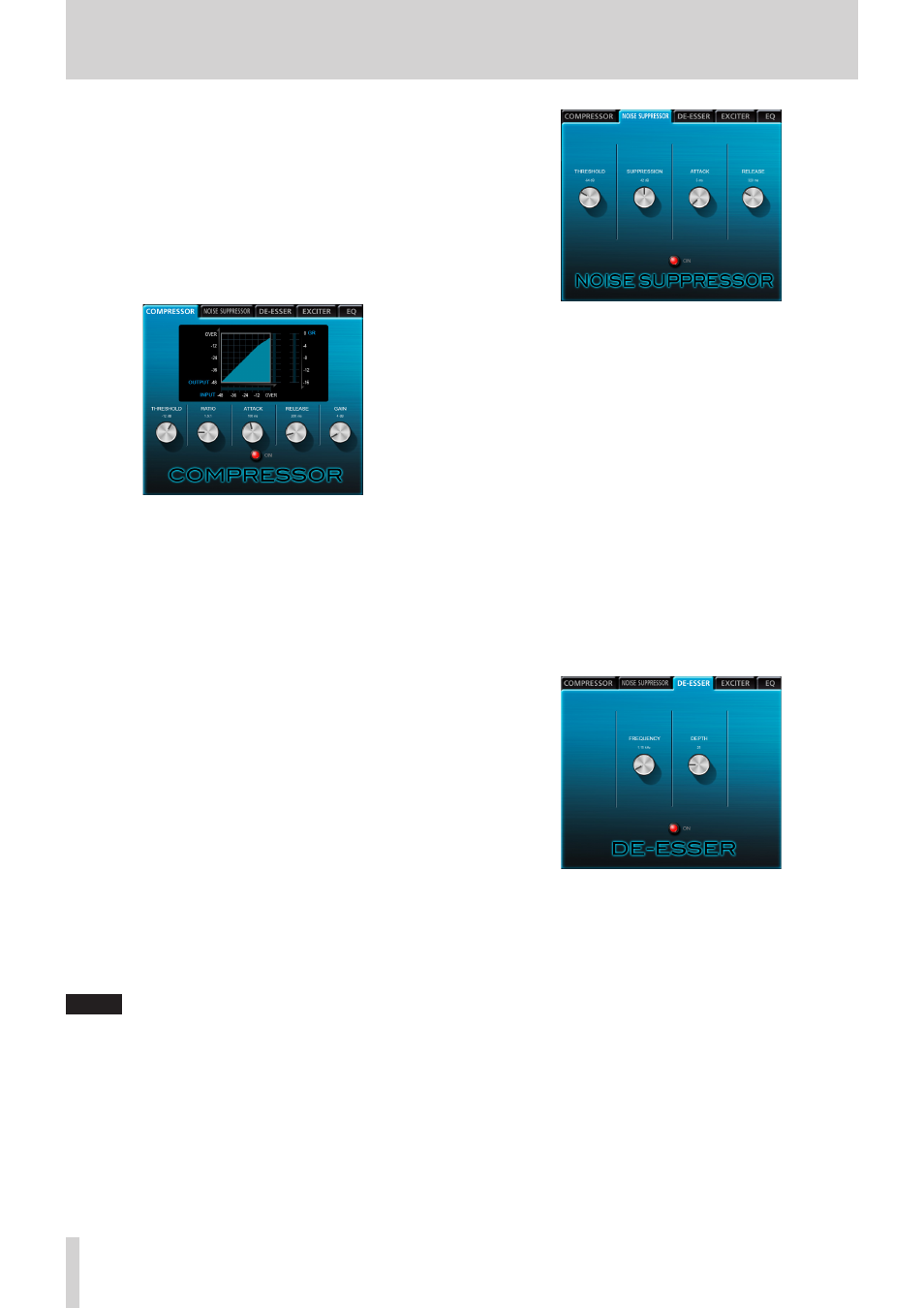See “effect explanations – Teac US-322 User Manual
Page 22

22
TASCAM US-322/366
5 – Using the US-322/366 Mixer Panel
8
Effect explanations
Dynamics effects
0
Compressor
When the input volume exceeds the “THRESHOLD” level set
in advance, the input volume will be compressed, reducing
output volume variation.
For example, by reducing the high level parts when sound
occurs, the lower level sounds become relatively louder,
creating a more even volume. You can also use this as a
limiter to prevent signal levels from becoming too high.
The three meters show the level of the signal input to the
compressor (“INPUT”), the level of the signal output from
the compressor (“OUTPUT”) and the gain reduction caused
by the compressor (“GR”).
THRESHOLD: −32 to 0 dB (default: –12dB)
Sets the threshold level that will cause the input signal
volume to be compressed when it is exceeded.
RATIO: 1.0:1 to inf:1 (default: 1.5:1)
Sets the compression ratio for the volume. Turning it
right raises the compression ratio, increasing the amount
of compression.
ATTACK: 2 to 200 ms (default: 20 ms)
Sets the amount of time until the compression reaches
the compression RATIO setting after the input sound
exceeds the threshold.
RELEASE: 10 to 1000 ms (default: 420 ms)
Sets the amount of time until the compression stops and
the sound returns to its uncompressed level after the
input sound goes below the threshold.
GAIN: 0 to 32 dB (default: 4 dB)
Sets the gain of the output signal. When the volume is
compressed, the output level becomes lower than the
input level.
Use the “GAIN” to amplify the output level so that it is
close to the input level.
If the input is a stereo signal, compression will start and
be applied to both channels when either the left or right
input channel exceeds the threshold level.
NOTE
When the compressor is off, the compressor curve will
appear but the meters will not be active.
0
Noise suppressor
When the input volume becomes less than the threshold
level set in advance, the output level will be reduced
automatically to suppress noise. When the threshold level
is exceeded, the sound will be output at its ordinary level.
This effect is useful in applications to reduce noise during
pauses in performance or other sound input.
THRESHOLD: −84 to −24 dB (default: −64 dB)
Sets the threshold level that will cause noise suppression
if the input signal becomes less than it.
SUPPRESSION: 12 to 72 dB (default: 42 dB)
Sets the amount the output level will be reduced when
the input sound becomes less than the threshold level.
The higher the value, the more the output level and
noise will be reduced.
ATTACK: 0 to 4000 ms (default: 5 ms)
Sets the amount of time until the set suppression level is
reached after the input sound goes below the threshold.
RELEASE: 0 to 4000 ms (default: 32 0 ms)
Sets the amount of time until suppression stops after the
input sound exceeds the threshold.
When the input is a stereo signal, if both the left and
right input channels go below the threshold level, noise
suppression will start.
0
De-esser
This is a compressor specialized for high frequencies that
reduces “s” sounds and other harsh high-frequency noises.
FREQUENCY: 1 to 4 kHz (default: 1.15 kHz)
Sets the lowest frequency that the de-esser effects.
DEPTH: 1 to 100 (default: 25)
Sets the amount of compression. The higher the value
the greater the compression (and de-essing effect).
